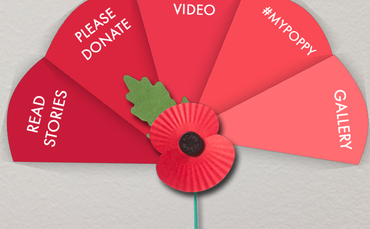The Times, Daily Express, i, Daily Telegraph, Daily Mail, Daily Star, Daily Mirror, Evening Standard and Metro launched the campaign to boost awareness of Remembrance Sunday, on 8 November, and Armistice Day, tomorrow (11 November), and to encourage donations to the Royal British Legion’s annual Poppy Appeal.
When readers scan the Legion’s poppy, which appears on newspaper mastheads, campaign posters and advertisements, using the Blippar app on their smartphones, the poppy turns into a 'portal' which offers access to pictures and videos of service men and women and stories of war, as well as encouraging people to donate to the Royal British Legion’s annual Poppy Appeal.

Legion's microsite
It also encourages people to talk about the campaign and appeal on social media using the hashtag #MyPoppy.
This is enabled without any change to the print. Blippar programs its software to recognise the poppies newspapers traditionally place on their mastheads at this time of year and to direct users to the Appeal's site. Blippar approached the Royal British Legion to ask if it could get involved and strengthen the Legion's existing relationships with the newspapers.
Blippar president of global marketing Omaid Hiwaizi said the campaign was a good way of reaching new audiences, particularly younger people.
“As a British company, it's an honour for us to highlight the fantastic work the Royal British Legion does," he added.
Gary Ryan, director of marketing and communications at The Royal British Legion, said using Blippar was an exciting way to bring the page to life and talk to more people about the charity’s vital work.
The campaign will be running all this week and follows on from other work with the Evening Standard and i newspapers.
Blippar was used on banknotes and the Evening Standard newspaper in September to offer readers added content about the Queen as she became this country’s longest-serving monarch. Features included being able to create a selfie with the Queen.
However, Blippar's main objective is more commercial. It is working with print publications and advertisers to draw readers into augmented reality advertising, driving readers to retail sites. US publication People StyleWatch, for example, has put Blippar on most of its pages.
"This makes the whole title shoppable and the bonus of that is a revenue model," Hiwaizi said. "We make content shoppable. People don't only just see the look, they can buy the look."
In addition Blippar collects data and tracks activity of users.
"I think what's going on with Blippar and newspapers and print was there was a period of experimentation and innovation and different print titles have tried different things at different times," Hiwaizi added.
"Now we're getting very confident about what works and what's a viable model. Now our partnerships don't look like experimentations, they look like strategic activities.
"I think print is changing, not dying, and I think Blippar and the like have provided an opportunity for expansion around [traditional] business models. We have big ideas as the Blippar technology matures."
Blippar was launched in 2011 and now has 50 million users. It has also worked with brands including Condé Nast, Time Inc, Unilever, Universal Pictures, Procter & Gamble, Coca-Cola and Jaguar.
Hiwaizi said that as well as continuing its work with print titles, Blippar is working on a 'visual browser' system where people can search the internet using a scan of a 3D object or living creature, rather than inputting text into a search engine, which will be functional within a few months. The Blippar team hopes that the term 'to Blip' will become as common as the phrase 'to Google'.
He added that the more Blippar is used by people in this way, the more value it will have as a tool for print publications to sell augmented reality advertising campaigns.










